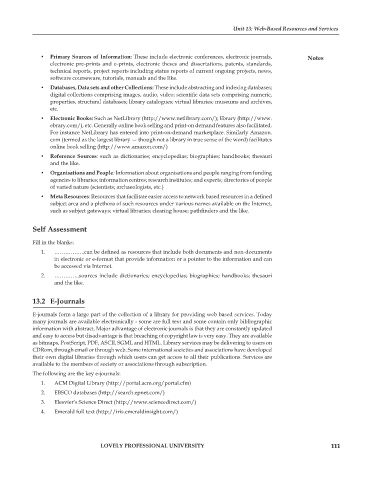Page 116 - DLIS407_INFORMATION AND LITERATURE SURVEY IN SOCIAL SCIENCES
P. 116
Unit 13: Web-Based Resources and Services
y Primary Sources of Information: These include electronic conferences, electronic journals, Notes
electronic pre-prints and e-prints, electronic theses and dissertations, patents, standards,
technical reports, project reports including status reports of current ongoing projects, news,
software courseware, tutorials, manuals and the like.
y Databases, Data sets and other Collections: These include abstracting and indexing databases;
digital collections comprising images, audio, video; scientific data sets comprising numeric,
properties, structural databases; library catalogues; virtual libraries; museums and archives,
etc.
y Electronic Books: Such as NetLibrary (http://www.netlibrary.com/); Ebrary (http://www.
ebrary.com/), etc. Generally online book selling and print-on demand features also facilitated.
For instance NetLibrary has entered into print-on-demand marketplace. Similarly Amazon.
com (termed as the largest library — though not a library in true sense of the word) facilitates
online book selling (http://www.amazon.com/)
y Reference Sources: such as dictionaries; encyclopedias; biographies; handbooks; thesauri
and the like.
y Organisations and People: Information about organisations and people ranging from funding
agencies to libraries; information centres; research institutes; and experts; directories of people
of varied nature (scientists; archaeologists, etc.)
y Meta Resources: Resources that facilitate easier access to network based resources in a defined
subject area and a plethora of such resources under various names available on the Internet,
such as subject gateways; virtual libraries; clearing house; pathfinders and the like.
Self Assessment
Fill in the blanks:
1. ……………..can be defined as resources that include both documents and non-documents
in electronic or e-format that provide information or a pointer to the information and can
be accessed via Internet.
2. …………..sources include dictionaries; encyclopedias; biographies; handbooks; thesauri
and the like.
13.2 E-Journals
E-journals form a large part of the collection of a library for providing web based services. Today
many journals are available electronically - some are full text and some contain only bibliographic
information with abstract. Major advantage of electronic journals is that they are constantly updated
and easy to access but disadvantage is that breaching of copyright law is very easy. They are available
as bitmaps, PostScript, PDF, ASCII, SGML and HTML. Library services may be delivering to users on
CDRom, through email or through web. Some international societies and associations have developed
their own digital libraries through which users can get access to all their publications. Services are
available to the members of society or associations through subscription.
The following are the key e-journals:
1. ACM Digital Library (http://portal.acm.org/portal.cfm)
2. EBSCO databases (http://search.epnet.com/)
3. Elesvier’s Science Direct (http://www.sciencedirect.com/)
4. Emerald full text (http://iris.emeraldinsight.com/)
LOVELY PROFESSIONAL UNIVERSITY 111

